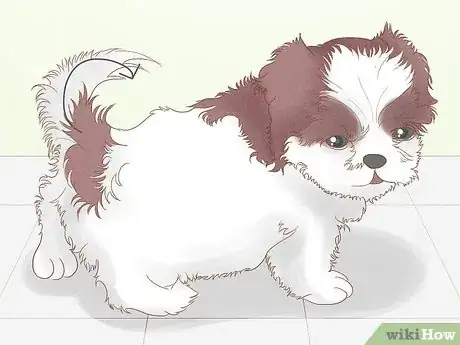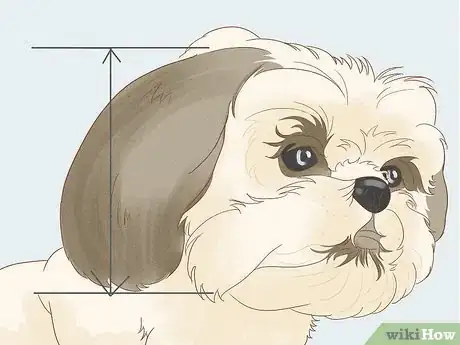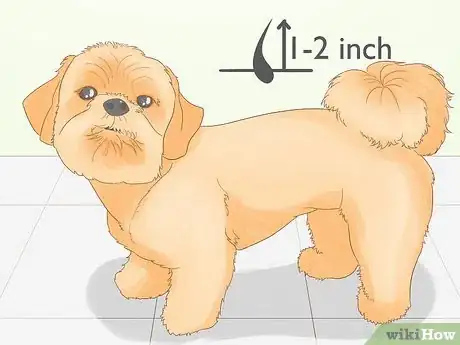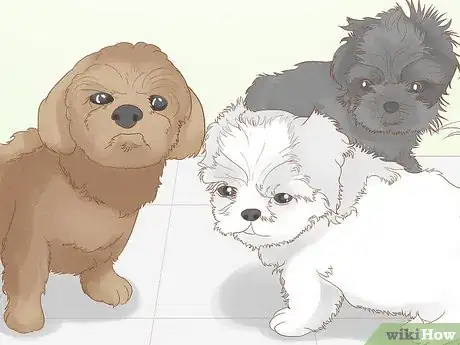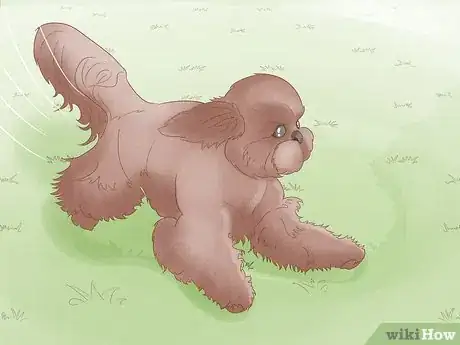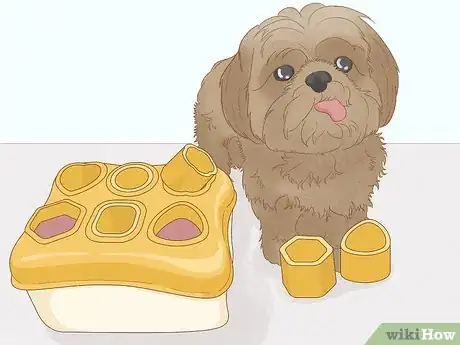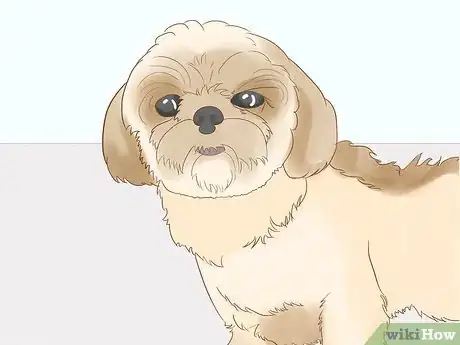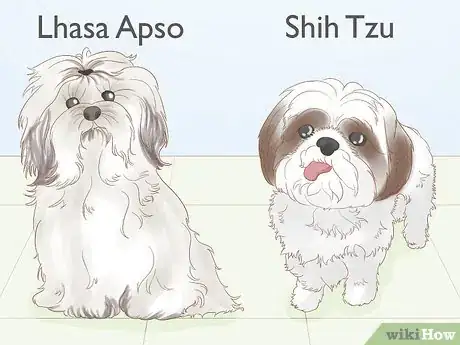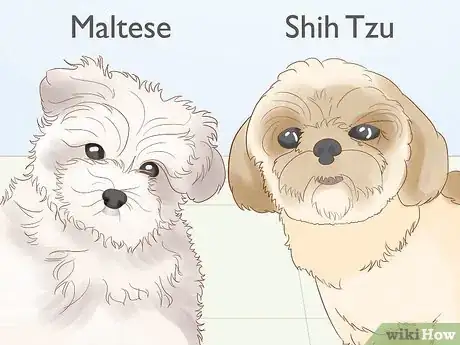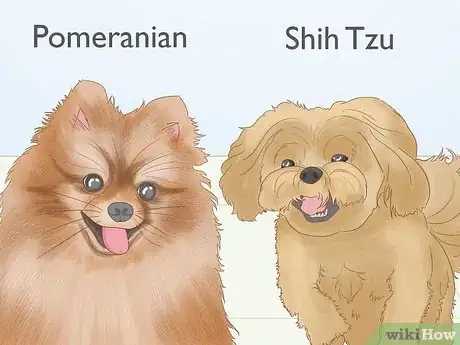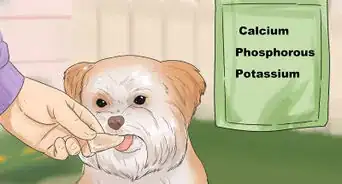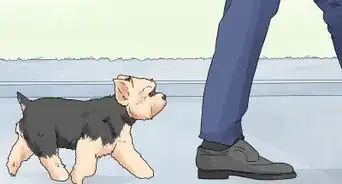This article was co-authored by Nicole Larocco-Skeehan. Nicole Larocco-Skeehan is a Dog Trainer and the Owner of Philly Unleashed in Philadelphia, Pennsylvania. Nicole has over 25 years of experience working with animals and currently specializes in group and private dog training and behavior modification. Nicole’s business has been named the "Best of Philadelphia" and she is the author of “The Teaching Dog: Partnering with Dogs for Instruction, Socialization, and Demonstration in Your Training Practice.” She was also on the Certification Council for Professional Dog Trainers Board of Directors. Nicole holds a Bachelor of Science in Marketing and Advertising from Robert Morris University.
There are 10 references cited in this article, which can be found at the bottom of the page.
This article has been viewed 149,907 times.
Steps
Recognizing Body Structure
-
1Notice the dog's size. There are two categories of Shih Tzu: normal and imperial (a slightly smaller version). Although you will not be able to identify these just by taking a quick glance, when placed next to one another, the size difference is noticeable. Both varieties of Shih Tzu are small, with the normal variety ranging from 8–11 inches (20–28 cm) tall.[3]
- Shih Tzu weigh between 9–16 pounds (4.1–7.3 kg) on average, being small dogs.[4]
-
2See if the dog has a curled tail. Shih Tzu have tails that curl over their backs. Their tails are high and heavily plumed.[5]Advertisement
-
3Look at the ears of the dog. The ears of a Shih Tzu are large and rest at the sides of the dog's head. Their ears are heavily coated.[6]
-
4Check the dog's eyes. Shih Tzu have large, wide eyes. Their eyes are very dark (though may be slightly lighter on liver and blue colored dogs), round, and "placed well apart", according to the AKC.[7]
-
5
Taking a Closer Look at the Coat
-
1
-
2Know that a Shih Tzu can be any color. Shih Tzu can be found with any color of coat, though some are rarer than others. The AKC equally accepts all colors and patterns on a Shih Tzu.[11] Many Shih Tzu are seen with two colors, mostly white and another color. Tri-colored and solid Shih Tzu are also seen.
-
3Feel the coat. Shih Tzu have double coats, meaning their costs have two layers. Their fur is long and flows when trimmed in a show cut and is described as "luxurious" and "dense" by the AKC.[12]
Identifying Temperament
-
1Look for a playful personality. Shih Tzu are known for having a playful demeanor. They are lively and outgoing, and they can make great companions for children due to their playful nature.[13]
-
2Notice high energy levels. The active nature of a Shih Tzu means that it needs regular exercise and playtime. Short walks and playing indoors can help a Shih Tzu release its energy.[14] Shih Tzu are likely to use their energy to seek attention.[15]
- A Shih Tzu may chew a lot; if so, you may be able to distract it with a variety of treats and teething rings, giving it choices that reflect its independent mindedness.
-
3See if the dog is affectionate. Shih Tzu love to spend time with their owners, demonstrating their affectionate nature. They are companion dogs and are sociable and friendly. They are gentle even around strangers.[16]
-
4Check for intelligence. Shih Tzu are intelligent dogs. They are quick to learn if taught correctly.[17] They can be trained to recognize sounds and commands, such as knowing when it is time to be washed by hearing the sound of running water.
-
5
Comparing Shih Tzu to Similar Breeds
Shih Tzu can be easily confused with several other dog breeds. However, knowing the differences between the breeds can help you tell whether the dog is a Shih Tzu.
-
1Know if the animal you spot is a Shih Tzu or a Lhasa Apso. Lhasa Apsos and Shih Tzu are related breeds and have much in common. They are both small dogs, though Lhasa Apsos are slightly larger than Shih Tzu, being roughly 10–11 inches (25–28 cm) tall.[19] Both dogs have long coats, but Lhasa Apsos are typically gold, black, white/cream, red, or a mix of these colors,[20] while Shih Tzu may be any color. Lhasa Apsos, like Shih Tzu, are affectionate, but are instead cautious around strangers.[21]
-
2Spot differences between a Shih Tzu and a Havanese. Shih Tzu and Havanese are very similar in appearance. Havanese are typically the same size as Shih Tzu, but may be an inch taller.[22] They both have long coats, but unlike a Shih Tzu, which has a flowy coat, a Havanese has more of a matted coat.[23] Havanese are also easier to train as they are not as stubborn.[24]
-
3Tell if a dog is a Shih Tzu or a Maltese. Shih Tzu and Maltese can also be easily confused with one another. One main difference between the breeds is that Maltese are noticeably smaller.[25] Maltese are only seen in white, while Shih Tzu have a wider range of coat colors. A Maltese has a single coat, while a Shih Tzu has a double coat.[26] Maltese can be excellent watchdogs as they have a tendency to bark.[27]
-
4Notice how Shih Tzu and Pekingese differ. Two oriental breeds, Shih Tzu and Pekingese have lots in common. They can both be seen in just about any color. However, the coat of a Shih Tzu is more dense than that of a Pekingese.[28] Pekingese are slightly smaller than Shih Tzu.[29] Pekingese can be good guard dogs and will alert you of any trouble.[30]
-
5Differentiate between Shih Tzu and Yorkies. The Yorkshire Terrier, or Yorkie, is another breed that is similar to the Shih Tzu. Both are small dogs, but Shih Tzu are the larger breed.[31] Yorkies have ears that stand upright, while Shih Tzu have ears that rest on the sides of the head. Both are affectionate, though Shih Tzu are more open to meeting new people.[32]
-
6See how Shih Tzu and Pomeranians differ. Shih Tzu and Pomeranians are both toy breeds; however, Pomeranians are one of the smallest dogs in the world and are smaller than Shih Tzu.[33] Shih Tzu have long, flowing fur, while Pomeranians have a puffy coat.[34] Both breeds are energetic and lively, though Shih Tzu are more open and Pomeranians take more time to warm up to people.[35]
Community Q&A
-
QuestionI lost my Shih Tzu but got another one. I am in doubt he is a true Shih Tzu because his eyes are small compared to the eyes of the one I lost. Does every Shih Tzu have large eyes, or is my new Shih Tzu a different breed?
 LinnieTop AnswererShih Tzu are known for their large, impressive eyes. It's possible for one to have slightly smaller eyes than another, but if you're doubting his breed, consider using a DNA test to see if he is a true Shih Tzu.
LinnieTop AnswererShih Tzu are known for their large, impressive eyes. It's possible for one to have slightly smaller eyes than another, but if you're doubting his breed, consider using a DNA test to see if he is a true Shih Tzu. -
QuestionDo Shih Tzu have split tongues?
 LinnieTop AnswererShih Tzu may have long, hanging tongues, but a dog should not have a split tongue. Take the dog to the vet immediately if it has a split tongue.
LinnieTop AnswererShih Tzu may have long, hanging tongues, but a dog should not have a split tongue. Take the dog to the vet immediately if it has a split tongue. -
QuestionCan some Shih Tzu puppies have a slightly longer snout?
 LinnieTop AnswererA Shih Tzu's muzzle is described as short and square with a flat front, and it is typically only one inch in length. It is possible for it to be slightly longer in certain dogs, but this is not common. If a dog has a noticeably longer muzzle or snout than this, it is probably a mixed breed or another breed of dog.
LinnieTop AnswererA Shih Tzu's muzzle is described as short and square with a flat front, and it is typically only one inch in length. It is possible for it to be slightly longer in certain dogs, but this is not common. If a dog has a noticeably longer muzzle or snout than this, it is probably a mixed breed or another breed of dog.
References
- ↑ https://www.akc.org/dog-breeds/shih-tzu/
- ↑ https://www.akc.org/dog-breeds/shih-tzu/
- ↑ https://www.akc.org/dog-breeds/shih-tzu/
- ↑ https://www.akc.org/dog-breeds/shih-tzu/
- ↑ http://images.akc.org/pdf/breeds/standards/ShihTzu.pdf
- ↑ http://images.akc.org/pdf/breeds/standards/ShihTzu.pdf
- ↑ http://images.akc.org/pdf/breeds/standards/ShihTzu.pdf
- ↑ http://images.akc.org/pdf/breeds/standards/ShihTzu.pdf
- ↑ http://images.akc.org/pdf/breeds/standards/ShihTzu.pdf
- ↑ https://www.petcarerx.com/article/shih-tzu-grooming-instructions/744
- ↑ http://images.akc.org/pdf/breeds/standards/ShihTzu.pdf
- ↑ http://images.akc.org/pdf/breeds/standards/ShihTzu.pdf
- ↑ https://www.dogtemperament.com/shih-tzu-temperament/
- ↑ https://www.akc.org/dog-breeds/shih-tzu/
- ↑ https://www.dogtemperament.com/shih-tzu-temperament/
- ↑ https://www.dogtemperament.com/shih-tzu-temperament/
- ↑ https://www.dogtemperament.com/shih-tzu-temperament/
- ↑ https://www.akc.org/dog-breeds/shih-tzu/
- ↑ https://www.rover.com/blog/lhasa-apso-vs-shih-tzu-whats-the-difference/
- ↑ https://www.rover.com/blog/lhasa-apso-vs-shih-tzu-whats-the-difference/
- ↑ https://www.rover.com/blog/lhasa-apso-vs-shih-tzu-whats-the-difference/
- ↑ https://officiallypets.com/shih-tzu-vs-havanese/
- ↑ https://officiallypets.com/shih-tzu-vs-havanese/
- ↑ https://officiallypets.com/shih-tzu-vs-havanese/
- ↑ https://dogsnet.com/maltese-vs-shih-tzu/
- ↑ https://dogsnet.com/maltese-vs-shih-tzu/
- ↑ https://dogsnet.com/maltese-vs-shih-tzu/
- ↑ https://www.animalwised.com/differences-between-the-pekingese-and-shih-tzu-1538.html
- ↑ https://www.animalwised.com/differences-between-the-pekingese-and-shih-tzu-1538.html
- ↑ https://www.animalwised.com/differences-between-the-pekingese-and-shih-tzu-1538.html
- ↑ https://dogsnet.com/shih-tzu-vs-yorkie/
- ↑ https://dogsnet.com/shih-tzu-vs-yorkie/
- ↑ https://dogsnet.com/pomeranian-vs-shih-tzu/
- ↑ https://dogsnet.com/pomeranian-vs-shih-tzu/
- ↑ https://dogsnet.com/pomeranian-vs-shih-tzu/

